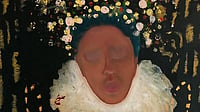Hormaz spent most of his idle hours not only just thinking of what to wear but staring at himself in the mirror, or having his younger brother who happened to be a cinematographer take photographs of him to post on Instagram stories and reels that were automatically linked to his Facebook feeds, as well.
Hormaz also happened to be a writer. He had published four slim volumes of prose-poems and short fiction. He had just completed A Fashion Dictionary, a collection of prose poems and short stories parading as dictionary entries, a veritable juxtaposition of real sartorial research. Apart from dressing and undressing, Hormaz spent his idle hours reading about the history of costumes.
He was particularly interested in the relationship between fashion and literature, so much so that under the dictionary entry Found Clothes, he did not fail to mention that Edgar Allen Poe was found dead on the street wearing someone else’s clothes. Most of the dictionary entries had reference to his literary tastes that spread across cultures. By and large, he was not interested in Anglo-American literature, culture and morality. He was far more intrigued by writers like Hermann Broch, Franz Kafka, Robert Walser, Amir Khusrau and Mir Taqi Mir. These names colourfully populated A Fashion Dictionary, like unending dresses and fabric populate wardrobes.
Hormaz had just completed writing A Fashion Dictionary, and felt so fortunate that a renowned, most fascinating anthropologist from Rome, M. Canevacci, had written such a spirited foreword for the book in Italian that was later translated into English by D. Khetarpal, a writer, translator, and lovely soul. Now, A Fashion Dictionary was complete, ready to send to either a literary agent or publisher. Unlike his earlier publications, Hormaz wished that A Fashion Dictionary would strike big, for which he needed a publisher with strong marketing talents.
Hormaz, however, had written nothing significant in the last six months apart from a few letters, long text messages, and emails to promote A Fashion Dictionary. Perhaps as a writer, he had reached a dry spell, not a writer’s block, perhaps a change in direction, a new calling in his life. He never was the kind to force his writing uselessly; while writing both his last books, Costumes of the Living and A Fashion Dictionary, he had spent much time thinking and writing about clothes and often he was not certain whilst sitting in his study whether he was actually writing or stitching clothes in a tailor’s shop. Hormaz felt that he had written enough and that the act of writing itself was quite painful, regardless of how comic his work was. He imagined that it would make more sense to become a tailor or fashion designer, instead.
As a result, he spent the next few years learning how to stitch clothes under the mentorship of a gentleman’s tailor, I. Memon in a one-horse town ridden with textiles—remains of a once flourishing mill history—developing a fashion brand called Adina and Hormaz. Adina, a Hebrew word, signifies softness, gentleness, kindness and warmth, just the kind of things Hormaz felt were missing from his life.
Hormaz never returned to the boring and torturous task of writing again, and though A Fashion Dictionary often gets cited at fashion and design schools across the world and was published by Bloomsbury, it never really made him any money or provided him a livelihood. It was, instead, the gentle kindness of Adina, a soft muslin-like spirit of that one-horse mill town ridden with fabric and tailors like I. Memon that wrapped Hormaz in layers of comfort, protection, strength, good health and abundance.
(This appeared in the print edition as "Adina and Hormaz")
(Views expressed are personal)
Gaurav Monga is a writer and teacher

























